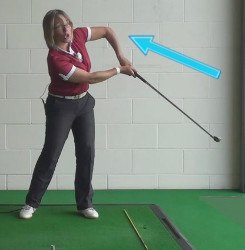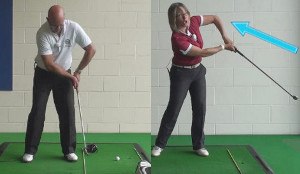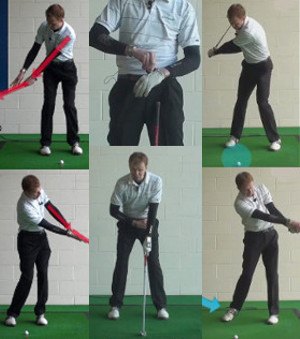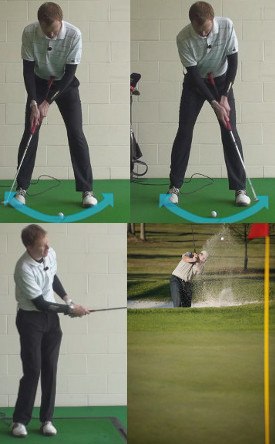The “Chicken Wing” is a unique name used to describe a common flaw in the golf swing. The term “Chicken Wing” describes when the lead arm bends at the elbow with a cupped lead wrist at impact. The result is a bent arm that looks like a chicken wing. The proper impact position creates a straight lead arm and wrist so the club can lag behind the hands until impact. This creates the proper downward angle of attack that optimizes swing speed, distance and accuracy. The chicken wing in the golf swing leads to a loss of power and creates additional loft at impact with excessive spin on the golf ball.

| GOLF FIXES BY PGA PROS |
|---|
| Golf Causes and Cures: Chicken Wing Slice – Tuck the Shirt Sleeve | Video | Article |
| How To Correct The Chicken Wing In The Golf Swing | Video | Article |
| How To Fix A Chicken Wing Golf Slice For Women Golfers, When Playing Golf | Video | Article |
| How Senior Golfers can Cure a Chicken Wing Golf Slice | Video | Article |
| LESSONS |
|---|
| The Permanent Chicken Wing In Lee Westwoods Golf Swing | Video | Article |
| Training Aids To Correct Your Chicken Wing Golf Swing | Video | Article |
| What Is A Chicken Wing In The Golf Swing | Video | Article |
| Top Two Tips On The Golf Chicken Wing Slice | Video | Article |
| Chicken Wing And Bent Arm During The Golf Backswing | Video | Article |
| Chicken Wing And Bent Arm During The Through Swing | Video | Article |
| PRACTICE DRILLS |
|---|
| Drill To Stop The Left Arm Chicken Wing | Video | Article |
| Drill To Stop The Left Arm Chicken Wing | Video | Article |
| Chicken Wing Drill | Video | Article |
| Causes Of The Chicken Wing In The Golf Swing | Video | Article |
| Drills To Cure The Chicken Wing In The Golf Swing | Video | Article |
| GOLF QUESTIONS |
|---|
| How Can I Stop a Chicken Wing? | Video | Article |
The Chicken Wing in the golf swing is a visual breakdown on the upper body at impact, however, the lower body is also a cause that leads to the unwanted movement. Generally the lower body fails to produce the necessary speed and efficiency through impact, therefore the arms and hands try to make up for the loss of power and speed. The correct forward swing sequence is initiated with the hips, shoulders followed by the arms and hands. When the upper body initiates the swing sequence the swing path often becomes excessively steep with an over the top motion. The swing generated by the steep downswing and lack of hip rotation can lead to a bent left arm at impact. In addition, the lower body is usually under rotated while the club does not release properly through impact.
Has anyone ever told you that your golf swing includes a ‘chicken wing’ move on the way through the ball? If so, they could be offering you an important insight into your swing technique, even if they didn’t bother to explain what that means. In this article, we are going to explain what a chicken golf swing is, how you can figure out if you are making this mistake, and how to get back on track. Also, we’ll talk about the chicken wing issue as it relates to the short game, since this can be a problem in that area, as well.
One of the reasons that many golfers struggle with the chicken wing problem in their swings is that it can be hard to notice when you are the one making the swing. If it’s the only way you’ve ever swung the club, it will feel natural to you – and you don’t have the perspective of an outside observer to notice that something is wrong. So, if someone else says something to you about this problem, it’s worth taking a closer look. They may or may not have diagnosed your swing correctly, but it’s a good idea to at least investigate further.
All of the content below is based on a right-handed golfer. If you happen to play left-handed, please take a moment to reverse the directions as necessary.
— What is a Chicken Wing?
We need to carefully explain what is meant by a ‘chicken wing’ swing before we can get to work on fixing this problem. If you don’t understand what we are talking about, you’ll have no way to identify this mistake properly, and you certainly won’t be able to make the right corrections.
When talking about a chicken wing move in the golf swing, we are talking about the action of the left arm through the hitting area. Specifically, those who are making this mistake are allowing their left arm to get out away from their body as the club swings through impact and into the finish. This is where the term ‘chicken wing’ comes from – when viewed from the face angle, the left arm bending out away from the body can somewhat resemble a chicken wing.
So, why is it a problem to let your left arm get away from your body as you swing through impact? Let’s take a look at some of the issues you’ll encounter when making this error.

- Poor release. At the heart of the problem here is the inability to release the club properly through the hitting area when you use a chicken wing follow through. Since the left arm is moving away from the body at impact, it is not going to be continuing to rotate along with the body. That means the face is going to be ‘held off’, so it won’t turn down to the left as you get through impact. There are a couple of issues with a poor release. For one thing, you will lose out on potential power when you don’t let the club head release fully through the ball. Also, it becomes harder to achieve a clean strike when your release is restricted. Solid ball strikers almost always do a great job of releasing the club head through impact, so you should be striving for that same ability.
- Awkward follow through. Making this mistake is going to give you trouble when you try to swing up into a full, balanced finished. Since your left arm will be pulling away from your body late in the downswing, you may find that your body as a whole wants to slide to the left. That is going to pull you off balance, and you’ll have to restrict your follow through to avoid falling over. Not only will you encounter plenty of ball striking problems along this road, but you may also find it hard to make a lot of swings without wearing down physically. You want your swing to be as fluid and balanced as possible in this game, and the chicken wing mistake is going to stand in your way while working toward that goal.
- Limited ball flight options. Ideally, you would be able to produce at least a couple of different ball flights while on the course, in order to navigate the various challenges that any given course design may throw your way. With the chicken wing, however, you may be limited to a single ball flight, which will make it harder to get around the course. For many people, that ball flight is going to be somewhere between a fade and a slice while the chicken wing is still a problem. You might be able to produce some reasonable shots from time to time while making this kind of swing, but it’s going to be tough to have the consistency – or versatility – that you need to shoot lower scores.
It’s hard to see how the chicken wing move through impact could mean anything positive for your golf game. If you can successfully remove this issue and replace it with improved rotation and a proper release, you’ll be on your way toward better golf. That isn’t going to be easy, of course, but it can be done.
— Are You Guilty?
Before you get too excited about trying to solve this problem, it’s important to make sure you are actually making this error. It would be a waste of time and effort to try to get rid of a mistake that isn’t actually taking place in your swing. Fortunately, it shouldn’t take long to determine whether or not the chicken wing left arm position is something that is plaguing your technique currently.
First, let’s talk about the easiest, and most reliable way to check on the status of your swing – recording your swing on video. You probably have a video recording device available to you in your smartphone, so there isn’t much standing in your way in terms of technology. When you visit the range, ask a friend to record a video of your swing so you can watch it for yourself and see how things look. The face-on angle is best for this purpose, since you’ll be able to see exactly how your left arm is behaving down through the hitting area.

Once you have taken a video, watch it a few times at full speed to see what you can spot. Even without slowing down or pausing the video, you may be able to see that your left arm is getting away from your body through impact. For a closer look, go ahead and pause the video as the club approaches impact and go frame by frame from that point. If you can see any significant amount of space between your upper left arm and the side of your body, you’ll know that the chicken wing is a problem that needs to be addressed.
Most people will be able to use video to identify the problem, but for discussion purposes, let’s say you either aren’t able to use video or simply don’t want to. What else can you do to diagnose the issue? Well, for one thing, you can simply think about the feel of your swing through impact. Does it feel like you are turning through the ball freely, or is something holding the club back from a proper release? Those who use a chicken wing swing often feel like they are ‘blocking’ the ball out toward the target, rather than swinging through it.
Another way to get to the bottom of this issue is to look at the results of your shots. If you are consistently hitting the ball far shorter than you expect to hit it, or far shorter than you used to hit it in the recent past, the chicken wing may be to blame. This swing mistake robs you of speed, so it’s likely that you will produce shots which are rather short. Also, you might hit the ball thin on a regular basis, as the chicken wing action prevents you from hitting down through the shot properly. These kinds of ball striking issues will help to clue you in that something is wrong with your technique.
Finally, one other option here is to get the help of a teaching professional. Most golf courses and driving range facilities have at least one or two teachers on staff, ready to help you make improvements in your swing technique. If you can’t decide for yourself if your move through the ball constitutes a chicken wing, paying for a lesson might be a worthwhile investment. You can explain to the teaching pro what you are trying to address, and he or she will be able to take a close look and point you in the right direction.
As an added bonus to this approach, you’ll likely get helpful tips on how to improve other parts of your swing. While many golfers spend money buying new clubs in the hopes to better their play, it’s often an investment in lessons that will pay a bigger dividend. Taking even just one or two lessons with a local pro should give you enough to work on to keep you busy at the range for months to come.
— Putting an End to the Flying Wing
For the purposes of this section of the article, we are going to assume that you are dealing with a chicken wing move in your swing. If that is the case, you’ll want to get started right away on making the necessary corrections. It’s going to take some time to get comfortable with a proper rotation and release through impact, so start as soon as you can to shorten your timeline.
The list below includes some ideas for how you can work on improving this important part of your swing.

- Start small. One of the best ways to fix a variety of swing ailments is to start small and work your way back up to bigger swings. This works as a method of improving your game because it allows you to slow things down and better feels what’s going on. If you make a full swing with a driver, for instance, the club may be moving at more than 100 miles per hour through the hitting area. That’s a lot of speed, and it makes it hard to get a good feel for how your body is behaving. By slowing it down and hitting some short, soft shots with a wedge, you’ll have more of an opportunity to feel the small moves within your swing. As it relates to the chicken wing, you can make it a point to keep your left arm connected to your body through impact on these short shots. Hit a bunch of half-speed wedge shots and pay close attention to how your left arm moves through the hitting area. If you notice that it is getting away from your body, make it a point to stay connected and try again. It should be easier to make adjustments with these soft swings than with a full swing. Only when you start to make progress and feel better about your connection should you work your way up into bigger and faster swings with longer clubs.
- Glove under your arm. This is perhaps the single best way to work on improving your chicken wing issue. While at the driving range, make some practice swings while holding a glove under your left arm. Prior to starting the swing, hold the club in your left hand while you use your right hand to place the glove (or a small towel), up under your left arm, into the armpit area. Then, simply make some practice swings. The goal here is to keep the glove in place throughout your practice swing. It’s okay if it drops out when you get all the way up into a full finish, but it should not drop before that point. If you find that the glove is falling out right as the club swings through the hitting area, you’ll know that the chicken wing is still an issue. Just thinking about keeping your arm down to pin the glove in place may be all you need to finally breakthrough and ditch this habit once and for all. Try going back and forth while on the range, making a few practice swings with the glove under your arm before hitting a couple of regular shots. Then, repeat the drill and follow it up with some more shots – you can continue this pattern for as long as you like. If you make this practice drill a regular part of your routine, it just might manage to keep your left arm connected and move you beyond the chicken wing for good.
- Work on a draw. This last suggestion is a good one to work into your process after you have made some progress with the tips above. Once you feel like the chicken wing is on its way out, and less of a problem than it used to be, start working on hitting some draw shots down the range. It’s awfully tough to produce a true draw when you have a chicken wing move through impact with your left arm, so your ability to produce some right-to-left shots is going to indicate that you are well on your way. Not only will this be nice confirmation that you have made meaningful progress, but it will also help you expand your options on the course. If you naturally play a fade as your standard shot shape, learning how to turn the ball over for a draw will give you more choices when you encounter certain situations during real rounds of golf.
Things tend to sound pretty easy when you read them in a blog post – and they rarely work out that easy once you are on the course. If you head out to your local range to work on your swing technique sometime soon, don’t be surprised if you struggle early on. And that’s okay. It’s always hard to make progress in this game, so be patient and look forward to the point when you can safely declare your chicken wing extinct.
— Chicken Wing and the Short Game
We are going to wrap up this discussion by talking about how the short game is impacted by the chicken wing issue. Right away, we need to make it clear that this error in the short game is not going to be as dramatic as it is in the long game. You are making shorter, slower swings in the short game, so you shouldn’t expect your left arm to fly away from your body as quickly as it can in a full swing. With that said, making this error can still cause problems on and around the greens, so the following points may help you get on track.

- A pure pendulum with the putter. You have probably heard the term ‘pendulum putting stroke’ before, and it refers to how you should be moving the putter back and through. To make your stroke, try putting the power over the movement of the putter in your shoulders, rather than your hands and wrists. Quite simply, you’ll try to rock your shoulders back and through, and the putter will go along for the ride. If you do this correctly, you won’t have to worry about any issues with a chicken wing left arm. Only if you let the control over the putter slip down into your hands, wrists, and arms will you have trouble with the chicken wing. As you practice, it can help to think about having as few moving parts as possible in your stroke. If you keep things quiet and just rock the putter back and through, it’s unlikely that the chicken wing will get in your way.
- Let the club release on chip shots. If you want to produce spin on your chip and pitch shots, and if you want to strike the shots cleanly time after time, you’ll need to let the club head release a bit through impact. That release isn’t going to be as aggressive as it is in the full swing, but the club should still turn through the hitting area to clip the ball and send it on its way. This release will be tough to accomplish with a chicken wing move, so try going back to the glove under the arm drill that we discussed earlier. Hit some chip shots with your glove placed under your left arm so you can get the feeling of staying connected and turning through the shot. With your whole upper body working together to swing the club toward the target, improved chipping performance should be right around the corner.
- Crucial in the bunker. It’s essential to avoid the chicken wing error when you are playing an explosion shot from the bunker. Yes, you are only a short distance from the green for this kind of shot, but you need a significant amount of speed to blast the ball up and onto the putting surface. With the chicken wing, you are going to struggle to develop speed and the club won’t release correctly through the sand. Yet again, the glove under the arm drill can make a big difference. Use this drill to practice the swing you will make in the sand, and keep the feeling from the drill in the back of your mind when hitting bunker shots.
It isn’t going to be easy to take the chicken wing move out of your swing. It’s hard to make any kind of swing change in this game, and that’s certainly true with something as significant as trying to eliminate the chicken wing action. If you are committed to making the change, however, you should be able to get there with a combination of hard work and attention to detail. We hope our tips will get you moving in the right direction with your swing – good luck and have fun!






